
9.2. The Emacs Editor
Text editors are among the most important applications in the Unix world. They are used so often that many people spend more time within an editor than anywhere else on their Unix system. The same holds true for Linux.
The choice of an editor can be a religious one. Many editors exist, but the Unix community has arranged itself into two major groups: the Emacs camp and the vi camp. Because of vi's somewhat nonintuitive user interface, many people (newcomers and seasoned users alike) prefer Emacs over vi. However, long-time users of vi (and single-finger typists) use it more efficiently than a more complex editor such as Emacs.
If vi is one end of the text-editor spectrum, Emacs is the other; they are widely different in their design and philosophy. Emacs is partly the brainchild of Richard Stallman, founder of the Free Software Foundation and author of much of the GNU software.
Emacs is a very large system with more features than any single Unix application to date (some people would even go so far as not to call it an editor but an "integrated environment"). It contains its own LISP language engine that you can use to write extensions for the editor. (Many of the functions within Emacs are written in Emacs LISP.) Emacs includes extensions for everything from compiling and debugging programs to reading and sending electronic mail to X Window System support and more. Emacs also includes its own online tutorial and documentation. The book Learning GNU Emacs by Debra Cameron, Bill Rosenblatt, and Eric Raymond (O'Reilly) is a popular guide to the editor.
Most Linux distributions include two variants of Emacs. GNU Emacs is the original version, which is still being developed, but development seems to have slowed down. XEmacs is larger, but much more user-friendly and better integrated with the X Window System (even though you can also use it from the command line, despite its name). If you are not tight on memory and have a reasonably fast computer, we suggest using XEmacs. Another advantage of XEmacs is that many useful packages that you would need to download and install separately with GNU Emacs are already shipped with XEmacs. We will not cover the differences here, though; the discussion in this section applies to both. Whenever we talk about Emacs in this section, we mean either version.
9.2.1. Firing It Up
GNU Emacs is simply invoked as:
$ emacs options
Likewise, XEmacs is invoked as:
$ xemacs options
Most of the time, you don't need options. You can specify filenames on the command line, but it's more straightforward to read them in after starting the program.
In Emacs lingo, C-x means Ctrl-X, and M-p is equivalent to Alt-P. As you might guess, C-M-p means Ctrl-Alt-P.
Using these conventions, press C-x followed by C-f to read in a file or create a new one. The keystrokes display a prompt at the bottom of your screen showing your current working directory. You can create a buffer now to hold what will end up being the content of a new file; let's call the file wibble.txt. We now see the following:
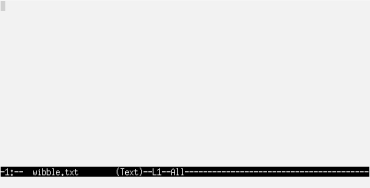
The mode line at the bottom indicates the name of the file as well as the type of buffer you're in (which here is Fundamental). Emacs supports many kinds of editing modes; Fundamental is the default for plain-text files, but other modes exist for editing C and TEX source, modifying directories, and so on. Each mode has certain key bindings and commands associated with it, as we'll see soon. Emacs typically determines the mode of the buffer based on the filename extension.
To the right of the buffer type is the word All, which means that you are currently looking at the entire file (which is empty). Typically, you will see a percentage, which represents how far into the file you are.
If you're running Emacs under the X Window System, a new window will be created for the editor with a menu bar at the top, scrollbars, and other goodies. In Section 11.6.2 in Chapter 11, we discuss Emacs's special features when used within X.
9.2.2. Simple Editing Commands
Emacs is more straightforward than vi when it comes to basic text editing. The arrow keys should move the cursor around the buffer; if they don't (in case Emacs is not configured for your terminal), use the keys C-p (previous line), C-n (next line), C-f (forward character), and C-b (backward character).
If you find using the Alt key uncomfortable, press Escape and then p. Pressing and releasing Escape is equivalent to holding down Alt.
Already we must take the first aside on our tour of Emacs. Literally every command and key within Emacs is customizable. That is, with a "default" Emacs configuration, C-p maps to the internal function previous-line, which moves the cursor (also called "point") to the previous line. However, you can easily rebind different keys to these functions, or write new functions and bind keys to them, and so forth. Unless otherwise stated, the keys we introduce here work for the default Emacs configuration. Later we'll show you how to customize the keys for your own use.
Back to editing: using the arrow keys or one of the equivalents moves the cursor around the current buffer. Just start typing text, and it is inserted at the current cursor location. Pressing the Backspace or Delete key should delete text at the cursor. If it doesn't, we'll show how to fix it in Section 9.2.8 later in this chapter. Now begin to type:
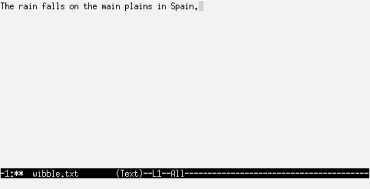
The keys C-a and C-e move the cursor to the beginning and end of the current line, respectively. C-v moves forward a page; M-v moves back a page. There are many more basic editing commands, but we'll allow the Emacs online documentation (discussed shortly) to fill those in.
In order to get out of Emacs, use the command C-x C-c. This is the first of the extended commands we've seen; many Emacs commands require several keys. C-x alone is a "prefix" to other keys. In this case, pressing C-x followed by C-c quits Emacs, first asking for confirmation if you want to quit without saving changes to the buffer.
You can use C-x C-s to save the current file, and C-x C-f to "find" another file to edit. For example, typing C-x C-f presents you with a prompt, such as:
Find file: /home/loomer/mdw/
where the current directory is displayed. After this, type the name of the file to find. Pressing the Tab key will do filename completion similar to that used in bash and tcsh. For example, entering:
Find file: /home/loomer/mdw/.bash
and pressing Tab opens another buffer, showing all possible completions, as so:
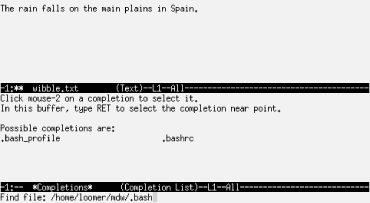
After you complete the filename, the *Completions* buffer goes away and the new file is displayed for editing. This is one example of how Emacs uses temporary buffers to present information.
Emacs allows you to use multiple buffers when editing text; each buffer may contain a different file you're editing. When you load a file with C-x C-f, a new buffer is created to edit the file, but the original buffer isn't deleted.
You can switch to another buffer using the C-x b command, which asks you for the name of the buffer (usually the name of the file within the buffer). For example, pressing C-x b presents the prompt:
Switch to buffer: (default wibble.txt)
The default buffer is the previous one visited. Press Enter to switch to the default buffer, or type another buffer name. Using C-x C-b will present a buffer list (in a buffer of its own), as so:
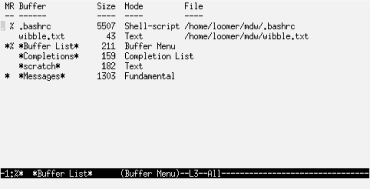
Popping up the buffer menu splits the Emacs screen into two "windows," which you can switch between using C-x o. More than two concurrent windows are possible as well. In order to view just one window at a time, switch to the appropriate one and press C-x 1. This hides all the other windows, but you can switch to them later using the C-x b command just described. Using C-x k actually deletes a buffer from Emacs's memory.
9.2.3. Tutorial and Online Help
Already Emacs looks a bit complex; that is simply because it's such a flexible system. Before we go any further, it is instructive to introduce Emacs's built-in online help and tutorial. This documentation has also been published in book form as the GNU Emacs Manual, by Richard M. Stallman (GNU Press).
Using the C-h command gives you a list of help options on the last line of the display. Pressing C-h again describes what they are. In particular, C-h followed by t drops you into the Emacs tutorial. It should be self-explanatory, and an interactive tutorial about Emacs tells you more about the system than we can hope to cover here.
After going through the Emacs tutorial you should get accustomed to the Info system, where the rest of the Emacs documentation resides. C-h followed by i enters the Info reader. A mythical Info page might look like this:
File: intercal.info, Node: Top, Next: Instructions, Up: (dir) This file documents the Intercal interpreter for Linux. * Menu: * Instructions:: How to read this manual. * Overview:: Preliminary information. * Examples:: Example Intercal programs and bugs. * Concept Index:: Index of concepts.
As you see, text is presented along with a menu to other "nodes." Pressing m and then entering a node name from the menu will allow you to read that node. You can read nodes sequentially by pressing the spacebar, which jumps to the next node in the document (indicated by the information line at the top of the buffer). Here, the next node is Instructions, which is the first node in the menu.
Each node also has a link to the parent node (Up), which here is (dir), meaning the Info page directory. Pressing u takes you to the parent node. In addition, each node has a link to the previous node, if it exists (in this case, it does not). The p command moves to the previous node. The l command returns you to the node most recently visited.
Within the Info reader, pressing ? gives you a list of commands and pressing h presents you with a short tutorial on using the system. Since you're running Info within Emacs, you can use Emacs commands as well (such as C-x b to switch to another buffer).
If you think that the Info system is arcane and obsolete, please keep in my mind that it was designed to work on all kinds of systems, including those lacking graphics or powerful processing capabilities.
Other online help is available within Emacs. Pressing C-h C-h gives you a list of help options. One of these is C-h k, after which you press a key, and documentation about the function that is bound to that key appears.
9.2.4. Deleting, Copying, and Moving Text
There are various ways to move and duplicate blocks of text within Emacs. These methods involve use of the mark, which is simply a "remembered" cursor location you can set using various commands. The block of text between the current cursor location (point) and the mark is called the region.
You can set the mark using the key C-@ (or C-Space on most systems). Moving the cursor to a location and pressing C-@ sets the mark at that position. You can now move the cursor to another location within the document, and the region is defined as the text between mark and point.
Many Emacs commands operate on the region. The most important of these commands deal with deleting and yanking text. The command C-w deletes the current region and saves it in the kill ring. The kill ring is a list of text blocks that have been deleted. You can then paste (yank) the text at another location, using the C-y command. (Note that the semantics of the term yank differ between vi and Emacs. In vi, "yanking" text is equivalent to adding it to the undo register without deleting it, while in Emacs, "yank" means to paste text.) Using the kill ring, you can paste not only the most recently deleted block of text, but also blocks of text that were deleted previously.
For example, type the following text into an Emacs buffer:

Now, move the cursor to the beginning of the second line ("Here is a line..."), and set the mark with C-@. Move to the end of the line (with C-e), and delete the region using C-w. The buffer should now look like the following:

In order to yank the text just deleted, move the cursor to the end of the buffer and press C-y. The line should be pasted at the new location:
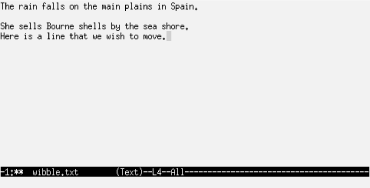
Pressing C-y repeatedly will insert the text multiple times.
You can copy text in a similar fashion. Using M-w instead of C-w will copy the region into the kill ring without deleting it. (Remember that M- means holding down the Alt key or pressing Escape before the w.)
Text that is deleted using other kill commands, such as C-k, is also added to the kill ring. This means that you don't need to set the mark and use C-w to move a block of text; any command that deletes more than one character will do.
In order to recover previously deleted blocks of text (which are saved on the kill ring), use the command M-y after yanking with C-y. M-y replaces the yanked text with the previous block from the kill ring. Pressing M-y repeatedly cycles through the contents of the kill ring. This feature is useful if you wish to move or copy multiple blocks of text.
Emacs also provides a more general register mechanism, similar to that found in vi. Among other things, you can use this feature to save text you want to paste in later. A register has a one-character name; let's use a for this example:
-
At the beginning of the text you want to save, set the mark by pressing the Control key and spacebar together (or if that doesn't work, press C-@).
-
Move point (the cursor) to the end of the region you want to save.
-
Press C-x x followed by the name of the register (a in this case).
-
When you want to paste the text somewhere, press C-x g followed by the name of the register, a.
9.2.5. Searching and Replacing
The most common way to search for a string within Emacs is to press C-s. This starts what is called an incremental search. You then start entering the characters you are looking for. Each time you press a character, Emacs searches forward for a string matching everything you've typed so far. If you make a mistake, just press the Delete key and continue typing the right characters. If the string cannot be found, Emacs beeps. If you find an occurrence but you want to keep searching for another one, press C-s again.
You can also search backward this way using the C-r key. Several other types of searches exist, including a regular expression search that you can invoke by pressing M-C-s. This lets you search for something like jo.*n, which matches names like John, Joan, and Johann. (By default, searches are not case-sensitive.)
To replace a string, enter M-%. You are prompted for the string that is currently in the buffer, and then the one with which you want to replace it. Emacs displays each place in the buffer where the string is and asks you if you want to replace this occurrence. Press the spacebar to replace the string, the Delete key to skip this string, or a period to stop the search.
If you know you want to replace all occurrences of a string that follow your current place in the buffer, without being queried for each one, enter M-x replace-string. (The M-x key allows you to enter the name of an Emacs function and execute it, without use of a key binding. Many Emacs functions are available only via M-x, unless you bind them to keys yourself.) A regular expression can be replaced by entering M-x replace-regexp.
9.2.6. Macros
The name Emacs comes partly from the word "macros." A macro is a simple but powerful feature that makes Emacs a pleasure to use. If you plan on doing anything frequently and repetitively, just press C-x (, perform the operation once, and then press C-x ). The two C-x commands with the opening and closing parentheses remember all the keys you pressed. Then you can execute the commands over and over again by pressing C-x e.
Here's a example you can try on any text file; it capitalizes the first word of each line.
-
Press C-x ( to begin the macro.
-
Press C-a to put point at the beginning of the current line. It's important to know where you are each time a macro executes. By pressing C-a you are making sure the macro will always go to the beginning of the line, which is where you want to be.
-
Press M-c to make the first letter of the first word a capital letter.
-
Press C-a again to return to the beginning of the line and C-n or the down arrow to go to the beginning of the following line. This ensures that the macro will start execution at the right place next time.
-
Press C-x ) to end the macro.
-
Press C-x e repeatedly to capitalize the following lines. Or press C-u several times, followed by C-x e. The repeated uses of C-u are prefix keys, causing the following command to execute many times. If you get to the end of the document while the macro is still executing, no harm is done; Emacs just beeps and stops executing the macro.
9.2.7. Running Commands and Programming within Emacs
Emacs provides interfaces for many programs, which you can run within an Emacs buffer. For example, Emacs modes exist for reading and sending electronic mail, reading Usenet news, compiling programs, and interacting with the shell. In this section, we'll introduce some of these features.
To send electronic mail from within Emacs, press C-x m. This opens up a buffer that allows you to compose and send an email message:
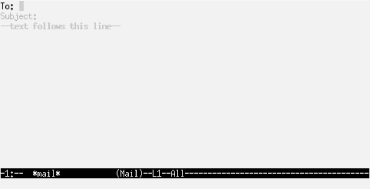
Simply enter your message within this buffer and use C-c C-s to send it. You can also insert text from other buffers, extend the interface with your own Emacs LISP functions, and so on. Furthermore, an Emacs mode called RMAIL lets you read your electronic mail right within Emacs, but we won't discuss it here because most people prefer standalone mailers. (Usually, these mailers let you choose Emacs as your editor for email messages.)
Similar to the RMAIL mail interface is GNUS, the Emacs-based newsreader, which you can start with the M-x gnus command. After startup (and a bit of chewing on your .newsrc file), a list of newsgroups will be presented, along with a count of unread articles for each:

GNUS is an example of the power of using Emacs interfaces to other tools. You get all the convenience of Emacs's navigation, search, and macro capabilities, along with specific key sequences appropriate for the tool you're using.
Using the arrow keys, you can select a newsgroup to read. Press the spacebar to begin reading articles from that group. Two buffers will be displayed, one containing a list of articles and the other displaying the current article.
Using n and p move to the next and previous articles, respectively. Then use f and F to post a follow-up to the current article (either including or excluding the current article), and r and R to reply to the article via electronic mail. There are many other GNUS commands; use C-h m to get a list of them. If you're used to a newsreader, such as rn, GNUS will be somewhat familiar.
Emacs provides a number of modes for editing various types of files. For example, there is C mode for editing C source code, and TEX mode for editing (surprise) TEX source. Each mode boasts features that make editing the appropriate type of file easier.
For example, within C mode, you can use the command M-x compile, which, by default, runs make -k in the current directory and redirects errors to another buffer. For example, the compilation buffer may contain:
cd /home/loomer/mdw/pgmseq/ make -k gcc -O -O2 -I. -I../include -c stream_load.c -o stream_load.o stream_load.c:217: syntax error before 'struct' stream_load.c:217: parse error before 'struct'
You can move the cursor to a line containing an error message and press C-c C-c to make the cursor jump to that line in the corresponding source buffer. Emacs opens a buffer for the appropriate source file if one does not already exist. Now you can edit and compile programs entirely within Emacs.
Emacs also provides a complete interface to the gdb debugger, which is described in Section 14.1.6.3 in Chapter 14.
Usually, Emacs selects the appropriate mode for the buffer based on the filename extension. For example, editing a file with the extension .c in the filename automatically selects C mode for that buffer.
Shell mode is one of the most popular Emacs extensions. Shell mode allows you to interact with the shell in an Emacs buffer, using the command M-x shell. You can edit, cut, and paste command lines with standard Emacs commands. You can also run single shell commands from Emacs using M-!. If you use M-| instead, the contents of the current region are piped to the given shell command as standard input. This is a general interface for running subprograms from within Emacs.
9.2.8. Tailoring Emacs
The Emacs online documentation should be sufficient to get you on track to learning more about the system and growing accustomed to it. However, sometimes it is hard to locate some of the most helpful hints for getting started. Here we'll present a rundown on certain customization options many Emacs users choose to employ to make life easier.
The Emacs personal customization file is .emacs, which should reside in your home directory. This file should contain code, written in Emacs LISP, which runs or defines functions to customize your Emacs environment. (If you've never written LISP before, don't worry; most customizations using it are quite simple.)
One of the most common things users customize are key bindings. For instance, if you use Emacs to edit SGML documents, you can bind the key C-c s to switch to SGML mode. Put this in your .emacs file:
; C-c followed by s will put buffer into SGML mode." (global-set-key "\C-cs" 'sgml-mode)
Comments in Emacs LISP start with a semicolon. The command that follows runs the command global-set-key. Now you don't have to type in the long sequence M-x sgml-mode to start editing in SGML. Just press the two characters C-c s. This works anywhere in Emacs — no matter what mode your buffer is in — because it is global. (Of course, Emacs may also recognize an SGML or XML file by its suffix and put it in SGML mode for you automatically.)
A customization that you might want to use is making the text mode the default mode and turning on the "auto-fill" minor mode (which makes text automatically wrap if it is too long for one line) like this:
; Make text mode the default, with auto-fill (setq default-major-mode 'text-mode) (add-hook 'text-mode-hook 'turn-on-auto-fill)
You don't always want your key mappings to be global. As you use TEX mode, C mode, and other modes defined by Emacs, you'll find useful things you'd like to do only in a single mode. Here, we define a simple LISP function to insert some characters into C code, and then bind the function to a key for our convenience:
(defun start-if-block( )
(interactive)
(insert "if ( ) {\n}\n")
(backward-char 6)
)We start the function by declaring it "interactive" so that we can invoke it (otherwise, it would be used only internally by other functions). Then we use the insert function to put the following characters into our C buffer:
if ( ) {
}Strings in Emacs can contain standard C escape characters. Here, we've used \n for a newline.
Now we have a template for an if block. To put on the ribbon and the bow, our function also moves backward six characters so that point is within the parentheses, and we can immediately start typing an expression.
Our whole goal was to make it easy to insert these characters, so now let's bind our function to a key:
(define-key c-mode-map "\C-ci" 'start-if-block)
The define-key function binds a key to a function. By specifying c-mode-map, we indicate that the key works only in C mode. There is also a tex-mode-map for mode, a lisp-mode-map that you will want to know about if you play with your .emacs file a lot.
If you'd like to write your own Emacs LISP functions, you should read the Info pages for elisp, which should be available on your system. Two good books on writing Emacs LISP functions are An Introduction to Programming in Emacs Lisp, by Robert J. Chassell (GNU Press) and Writing GNU Emacs Extensions, by Bob Glickstein (O'Reilly).
Now here's an important customization you may need. On many terminals the Backspace key sends the character C-h, which is the Emacs help key. To fix this, you should change the internal table Emacs uses to interpret keys, as follows:
(keyboard-translate ?\C-h ?\C-?)
Pretty cryptic code. \C-h is recognizable as the Control key pressed with h, which happens to produce the same ASCII code (8) as the Backspace key. \C-? represents the Delete key (ASCII code 127). Don't confuse this question mark with the question marks that precede each backslash. ?\C-h means "the ASCII code corresponding to \C-h." You could just as well specify 8 directly.
So now, both Backspace and C-h will delete. You've lost your help key. Therefore, another good customization would be to bind another key to C-h. Let's use C-\, which isn't used often for anything else. You have to double the backslash when you specify it as a key:
(keyboard-translate ?\C-\\ ?\C-h)
On the X Window System, there is a way to change the code sent by your Backspace key using the xmodmap command, but we'll have to leave it up to you to do your own research. It is not a completely portable solution (so we can't show you an example guaranteed to work), and it may be too sweeping for your taste (it also changes the meaning of the Backspace key in your xterm shell and everywhere else).
There are other key bindings you may want to use. For example, you may prefer to use the keys C-f and C-b to scroll forward (or backward) one page at a time, as in vi. In your .emacs file you might include the following lines:
(global-set-key "\C-f" 'scroll-up) (global-set-key "\C-b" 'scroll-down)
Again, we have to issue a caveat: be careful not to redefine keys that have other important uses. (One way to find out is to use C-h k to tell you what a key does in the current mode. You should also consider that the key may have definitions in other modes.) In particular, you'll lose access to a lot of functions if you rebind the prefix keys that start commands, such as C-x and C-c.
You can create your own prefix keys, if you really want to extend your current mode with lots of new commands. Use something like:
(global-unset-key "\C-d") (global-set-key "\C-d\C-f" 'my-function)
First, we must unbind the C-d key (which simply deletes the character under the cursor) in order to use it as a prefix for other keys. Now, pressing C-d C-f will execute my-function.
You may also prefer to use another mode besides Fundamental or Text for editing "vanilla" files. Indented Text mode, for example, automatically indents lines of text relative to the previous line so that it starts in the same column (as with the :set ai function in vi). To turn on this mode by default, use:
; Default mode for editing text (setq default-major-mode 'indented-text-mode)
You should also rebind the Enter key to indent the next line of text:
(define-key indented-text-mode-map "\C-m" 'newline-and-indent)
Emacs also provides "minor" modes, which are modes you use along with major modes. For example, Overwrite mode is a minor mode that causes newly typed characters to overwrite the text in the buffer, instead of inserting it. To bind the key C-r to toggle overwrite mode, use the command:
; Toggle overwrite mode. (global-set-key "\C-r" 'overwrite-mode)
Another minor mode is Autofill, which automatically wraps lines as you type them. That is, instead of pressing the Enter key at the end of each line of text, you may continue typing and Emacs automatically breaks the line for you. To enable Autofill mode, use the commands:
(setq text-mode-hook 'turn-on-auto-fill) (setq fill-column 72)
This turns on Autofill mode whenever you enter Text mode (through the text-mode-hook function). It also sets the point at which to break lines at 72 characters.
9.2.9. Regular Expressions
Even a few regular expression tricks can vastly increase your power to search for text and alter it in bulk. Regular expressions were associated only with Unix tools and languages for a long time; now they are popping up in other environments, such as Microsoft's .NET, but only Unix offers them in a wide variety of places, such as text editors and the grep command where ordinary users can exploit them.
Let's suppose you're looking through a file that contains mail messages. You're on a bunch of mailing lists with names, such as gyro-news and gyro-talk, so you're looking for Subject lines with gyro- in them. You can use your text editor or the grep command to search for:
^Subject:.*gyro-
This means "look for lines beginning with Subject:, followed by any number of any kind of character, followed by gyro-." The regular expression is made up of a number of parts, some reproducing the plain text you're looking for and others expressing general concepts like "beginning of line." Figure 9-1 shows what the parts mean and how they fit together.
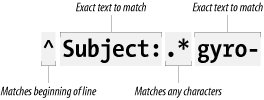
Figure 9-1. Simple regular expression
Just to give a hint of how powerful and sophisticated regular expressions can be, let's refine the one in Figure 9-1 for a narrower search. This time, we know that mailing lists on gyros send out mail with Subject lines that begin with the name of the list in brackets, such as Subject: [gyro-news] or Subject: [gyro-talk]. We can search for precisely such lines, as follows:
^Subject: *\[gyro-[a-z]*\]
Figure 9-2 shows what the parts of this expression mean. We'll just mention a couple of interesting points here.

Figure 9-2. Regular expression with more parts
Brackets, like carets and asterisks, are special characters in regular expressions. Brackets are used to mark whole classes of characters you want to search for, such as [a-z] to represent "any lowercase character." We don't want the bracket before gyro to have this special meaning, so we put a backslash in front of it; this is called escaping the bracket. (In other words, we let the bracket escape being considered a metacharacter in the regular expression.)
The first asterisk in our expression follows a space, so it means "match any number of spaces in succession." The second asterisk follows the [a-z] character class, so it applies to that entire construct. By itself, [a-z] matches one and only one lowercase letter. Together, [a-z]* means "match any number of lowercase letters in succession."
A sophisticated use of regular expressions can take weeks to learn, and readers who want to base applications on regular expressions would do well to read Mastering Regular Expressions, by Jeffrey Friedl (O'Reilly).

Copyright © 2003 O'Reilly & Associates. All rights reserved.



